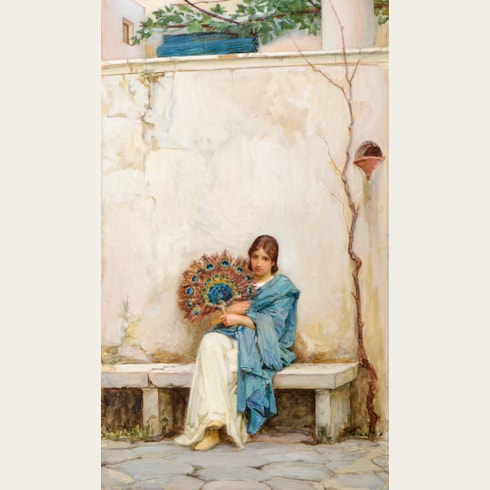John William WATERHOUSE
(Rome 1849 - London 1917)
The Head of a Woman
Sold
Pen and brown ink and brown wash, over an underdrawing in pencil.
A sketch of a column in pencil at the right edge, folded over.
Fragments of a red wax seal at the extreme left and right edges of the sheet, folded over.
261 x 293 mm. (10 1/4 x 11 1/2 in.) [image]
332 x 530 mm. (13 1/8 x 20 7/8 in.) [sheet]
A sketch of a column in pencil at the right edge, folded over.
Fragments of a red wax seal at the extreme left and right edges of the sheet, folded over.
261 x 293 mm. (10 1/4 x 11 1/2 in.) [image]
332 x 530 mm. (13 1/8 x 20 7/8 in.) [sheet]
This pen and wash sketch of the head of a woman was formerly mounted onto the reverse of a finished watercolour by Waterhouse exhibited at the Dudley Gallery in London in 18791. The present sheet is very similar in style, coiffure and physiognomy to the main figure in a finished sepia drawing by Waterhouse entitled At a Greek Play, showing a woman holding a fan of peacock feathers. That drawing, which was exhibited at the Dudley Gallery’s Black and White Exhibition in 1880 but is now lost, is known today from a large reproductive engraving published in The Illustrated London News in 1881.
Writing in 1895, the critic Alfred Lys Baldry noted of Waterhouse’s work of this period that he ‘was seeking among the fascinations of classic genre the direction in which he occupy himself with best effect. But even then there was something of originality in the in the shape which he gave to his interpretations of themes comparatively well worn...Classic genre, as he treated it, was less anecdotal than reflective, less pictorial story-telling than an excuse quite sufficiently plausible for presenting Nature in a shape all the more becoming because not strictly in keeping with modern conventions. People who remember the sunny, sparkling canvases, small in size and glowing with colour, which Mr. Waterhouse contributed to the exhibitions at the end of the seventies, and in the early eighties, will feel even now a debt of gratitude for such glimpses into a brighter world.’
Writing in 1895, the critic Alfred Lys Baldry noted of Waterhouse’s work of this period that he ‘was seeking among the fascinations of classic genre the direction in which he occupy himself with best effect. But even then there was something of originality in the in the shape which he gave to his interpretations of themes comparatively well worn...Classic genre, as he treated it, was less anecdotal than reflective, less pictorial story-telling than an excuse quite sufficiently plausible for presenting Nature in a shape all the more becoming because not strictly in keeping with modern conventions. People who remember the sunny, sparkling canvases, small in size and glowing with colour, which Mr. Waterhouse contributed to the exhibitions at the end of the seventies, and in the early eighties, will feel even now a debt of gratitude for such glimpses into a brighter world.’
The son of an English painter working in Rome, John William Waterhouse lived in Italy until he was about five years old. (Throughout his life, he was known among family and close friends as ‘Nino’, short for ‘Giovannino’.) He trained with his father before entering the Royal Academy Schools in 1870, aged twenty-one. He began exhibiting at the Society of British Artists in 1872, and made his debut at the Royal Academy two years later, with a painting of Sleep and his Half-Brother Death. He also began showing at the Dudley Gallery in 1875. In much of Waterhouse’s early work, the influence of the classicizing paintings of Lawrence Alma-Tadema is evident; these works proved to be commercially successful and earned the artist a steady income.
The 1880’s saw a distinct change in Waterhouse’s style, with the yearly exhibition at the Royal Academy of a succession of large, dramatic canvases of historical or literary subjects. These grand and imposing canvases - Diogenes (1882), The Favourites of the Emperor Honorius (1883), Consulting the Oracle (1884), Saint Eulalia (1885), The Magic Circle (1886), Mariamne (1887) and The Lady of Shalott (1888) – resulted in the precocious artist reaching the heights of his public fame. Waterhouse was elected an Associate Member of the Royal Academy in 1885, at a relatively young age for such an honour, rising to full Membership in 1893. He continued to exhibit large-scale subject pictures – generally of beautiful women from mythology, literature or poetry, with titles such as Circe, Danaë, Hylas and the Nymphs, Ariadne, Echo and Narcissus, Ophelia, Flora and the Zephyrs and La Belle Dame sans Merci - in which his mastery of colour and figure drawing is readily evident. Waterhouse was also a gifted portrait painter, always of women, although only a handful of these works were exhibited.
Provenance
Arthur Tooth and Sons, Ltd., London.





